Introduction
Emerging adulthood is typically defined as ages 18-25 years and is a unique developmental period when young people’s independence and self-sufficiency are increasing.1 Here, an individual is not dependent like a child or responsible like an adult but rather somewhere in between. The three criteria which are important markers of reaching adult status are accepting responsibility for oneself, making independent decisions and becoming financially independent, all of which are attained in the course of emerging adulthood.2,3 In developing countries, emerging adulthood is often experienced in urban areas but rarely in rural areas. This is the age where many individuals are attending college, which then becomes a key transitional period.1 According to Greaney et al.,4 there is greater lifestyle freedom in emerging adulthood than ever before.
Every year a large population of students enrol in college for higher education courses; this makes many adults leave their homes and make a new living arrangement in the city from where they are perusing higher education.5 In such cases, they tend to either live in rented accommodations on sharing or non-sharing basis, or in the hostels of Institutes where they are studying. Many of the emerging adults are moving away from their parental homes for the first time to live in hostels or paying guest/ rented accommodations. Compared with living at home or in on-campus hostels, independent apartment living offers the greatest freedom from parents and other adult authorities. With changes in their living arrangements, they have to learn to fend for themselves and adapt to the new environments. Previous researches have indicated that living arrangements influence lifestyle factors such as food choices, nutrient content of the diet, alcohol consumption, smoking, and dieting.6-9 Due to independent living, good dietary habits decline10; and poor dietary habits often tend to get worse.11 Dietary practices established during college are likely to be maintained for life and will impact the future health of the college student.12 According to Yusko et al.,13 rates of heavy alcohol use, tobacco use, and illicit substance use peak between the ages of 18 and 25. Brunt and Rhee14 reported that students who lived off-campus consumed more alcohol and smoked as compared to those students who lived on-campus or with parents.
The new found independence of emerging adults may have an impact on their eating habits and lifestyle patterns, consequently affecting their dietary intakes and nutritional status. It has also been noticed that as emerging adults begin to lead independent lives outside the previous constraints of their family homes, the health behaviours followed during this period may set the stage for establishing long-term behaviours that have an important impact on lifetime disease risk,15-17 as many of them are responsible for their own meal provision and food acquisition for the first time in their lives. Though some research has been done earlier on the dietary intakes and nutritional status of college students living at home and in on-campus hostels in India; there are very few studies that have focused on the effects of different living arrangements (on-campus, off-campus, and living with parents) of emerging adults. The present study was, therefore, undertaken to assess and compare the dietary practices, lifestyle patterns and nutritional status of emerging male adults (18-25 years) in different living arrangements i.e. living at home, living in on-campus hostels, and living in off-campus rented accommodations.
Materials and Methods
The present study was carried out in the National Capital Region of India. Using purposive sampling technique, a total of 75 emerging adult males in the age group of 18-25 years; 25 males each living at home with family, living in on-campus hostels, and living in rented accommodations were identified to constitute the study sample. The inclusion criteria was that the males should be studying in college or any other educational institute, and should be unmarried. Males who lived in paying guest accommodations where food was being provided or those who were working were not included in the study. Informed consent was taken from the identified males before including them as study participants and ethical procedures were followed for data collection.
A well-structured questionnaire-cum-interview schedule was prepared with methodological procedure which included questions regarding general profile, dietary practices and lifestyle patterns such as meal frequency, eating out, skipping meals, fasting, activity patterns, smoking, drinking etc. The questionnaires for participants living in hostels and in rented accommodations also contained a few additional questions specific to their living arrangements. Dietary intake data were gathered using 24-hour diet recall method for two days, one each for a working and non-working day. The participants were asked to recall and report details of dishes consumed in each meal along with their portion sizes in household measures and ingredients used in them. Standardization of various food items/ dishes was carried out to obtain information about the amounts of food ingredients used in different recipes and in different portion sizes. Information obtained from the participants was translated into raw weights of food ingredients using standardized recipes. The mean intake of energy and various nutrients was then calculated for participants in the three study groups using the Indian food composition database18 and compared with the recommended dietary allowances (RDA) for the same for adult sedentary males.19 Anthropometric measurements such as weight and height were recorded for all the participants. Based on these measurements, their body mass index (BMI) was determined and the BMI classifiaction given by Misra et al.,20 was used to categorize the participants as obese, overweight, normal and underweight.
Data obtained from the participants were subjected to qualitative and quantitative analysis with the help of Statistical Package for Social Sciences, SPSS version 16.0. The frequency and percentages were calculated for general profile, lifestyle patterns, dietary practices and BMI. A significant difference in these aspects between the three study groups of emerging male adults in different living arrangements was determined using the Chi square test. Mean and standard deviations were calculated for nutrient intakes and anthropometric variables. ANOVA and Tukey’s HSD test were used to assess the significant difference between the nutrient intakes of three groups of emerging male participants.
Results and Discussion
The male participants living at home have been referred to as HOM group, participants living in on-campus hostels as HOS group, and participants living in rented accommodations as RA group.
General Profile
The participants in the study were between ages 18-25 years; and the mean age of RA group participants at 22.9±1.1 years was significantly higher as compared to participants from HOM and HOS groups who had a mean age of 21.5±1.2 and 21.9±1.3 years respectively. Data on general profile of the participants have been presented in Table 1.
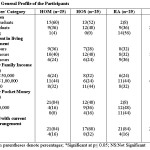 |
Table 1: General Profile of the Participants Click here to View table |
Maximum percentages of participants from HOM and HOS groups were enrolled in undergraduate courses while maximum from RA group were enrolled in coaching institutes for preparing for competitive exams. The highest percentage of participants from RA group spent maximum time, i.e. more than 16 to 18 hours, in their living arrangement as they did not spend much time in leisure or other activities and headed back to their accommodations after their coaching classes. The monthly family income of two-thirds of participants in all the three groups was more than Rupees 50,000/-. Majority of participants (84%) staying at home received a comparatively low pocket money of Rupees 5000/- per month as compared to their counterparts from HOS and RA groups who received higher amounts as they had to fend for themselves in many aspects of daily living. About 68% participants from the HOS group were satisfied with their current living arrangements as compared to a higher percentage (84% each) of participants from the other two groups.
Lifestyle Patterns
Data on lifestyle patterns of the study participants have been presented in Table 2. Majority of participants from the three study groups slept for an adequate amount of about 7 to 9 hours daily. Maximum percentages of subjects from RA (96%) and HOM (76%) groups spent about 6 to 8 hours daily doing occupational activities related to their studies. In the hostel, because of presence of other batch mates, the environment sometimes compels either everyone to study more or enjoy more so not much difference was seen among the subjects who spent different amounts of time in occupational activities. Higher percentages of participants from the HOM and RA groups reported that they performed exercises such as jogging and calisthenics including push-ups, sit-ups, stretching, jumping etc, however, their weekly frquency and duration of performing such exercises was low as comaperd to the HOS group. Nearly 80% of the HOS group particpants reported playing outdoor games like cricket, football, basketball and badminton more regularly as they had easy access to playgrounds and lawns in their hostel campus. Moreover, as most outdoor games were played in teams, HOS group participants could have easy access to their hostel mates and play with them. Only about half the subjects from RA group reported that they played outdoor games. A similar finding was also reported by Lupi et al.,21 in their recent study on undergraduate university students where students living alone dedicated less time to sports.
A significantly high percentage of RA group participants consumed alcohol as compared to the others, while smoking was reported by equal percentages of participants from HOS and RA groups due to greater independence and freedom from parental control. Studies have reported that that drinking and smoking was more common among college students who lived in residence halls or independently than among those living at home.14,22-23
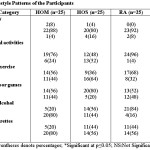 |
Table 2: Lifestyle Patterns of the Participants Click here to View table |
Dietary Practices
As presented in Table 3, data on dietary practices revealed that more than half of the participants in the HOM group were vegetarians while higher percentages of participants in the other two groups were either non-vegetarians or ovo-vegetarians. Highest percentage of participants from HOS group (44%) had regular meal timings comapred to their counterparts at home and in rented accommodations as they were being provided meals in the hostel mess at fixed hours. Maximum percentage of participants from HOM (56%) and RA (44%) groups had three meals, while those from HOS group (68%) had four or more meals daily. About 60% participants from all three groups reported that they skipped meals regularly, mainly breakfast or lunch due to rigid college/coaching hours and class timings, non-availability of food of choice, and lack of appetite. Choi and Lee24 in their study on the relationship of college students’ residence to meal skipping also reported that residence status did not influence meal skipping, and poor dietary practices among this population were likely to be due to time constraints.
Only a small percentage of participants from all three groups observed fasts mainly due to religious reasons. Maximum participants from the three study groups reported to be eating out either once or twice a week, mostly in the company of their friends; maximum percentages also consumed fried foods just once a week. One to three cups of tea or coffee were consumed daily by about 60% participants from the three groups. All participants reported consumption of convenience foods; and consumption of items such as instant soups and noodles, frozen foods, ready-to-eat foods, chips, namkeens, and juices was higher among RA group; the difference however was not statistically significant among the three groups. A study by Ansari et al.,25 on University students in four European countries also reported that moving out from parental homes was not accompanied by a significant increase in consumption of fast foods, snacks, or sweet consumption by the students.
Participants from HOS and RA groups gave some additional information which was specific for their living arrangements. All participants in HOS group had similar hostel mess timings that provided 4 meals per day. If any meal was missed by the participant, the hostel did not compensate for it but allowed the participants to prepare Maggi, egg, tea/coffee etc. in their hostel rooms. About three-fourths of the HOS subjects (76%) reported dissatisfaction about food served in the hostel mess due to unhygienic cooking and serving areas, non-satisfactory taste, inconsistency of cooking method, improper menu combination and limited food choices available to them. Majority of the RA group participants were satisfied and did not feel burdened about their food-related responsibilities. About 56% of them reported that two meals were cooked in a day which included lunch and dinner; while 22% mentioned that only one meal was cooked in a day which was consumed for both lunch and dinner, as the hired help/cook came to their residence only once in a day; another 22% participants reported that breakfast, lunch and dinner were prepared daily at their residence. Both HOS and RA group participants visited local friends or relatives to have home cooked food once in a while.
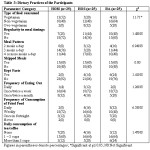 |
Table 3: Dietary Practices of the Participants Click here to View table |
Nutrient Intake
Table 4 gives the data on mean daily nutrient intake of the participants in the three study groups. It was found that the mean intake of energy, carbohydrates, vitamin A, riboflavin and niacin was lower than the recommended dietary allowances for sedentary adult man19 for participants in all the three groups while the intake of protein, total fat, calcium, vitamin C, thiamine and vitamin B12 was higher. Mean iron intake of HOS group was nearly similar to the RDA but was lower for the other two groups. Statistically significant differences were found among the three study groups for the mean intake of energy, protein, carbohydrates, calcium and riboflavin, with the intake being highest for the participants from HOS group. Similar results were reported in a study by Laska et al.,26 wherein young adults living with their parents and those living on their own in rented apartments or houses exhibited the poorest dietary intakes while those living on college and university campuses reported the most favourable diet and meal patterns.
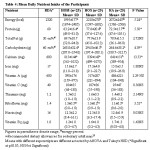 |
Table 4: Mean Daily Nutrient Intake of the Participants Click here to View table |
Anthropometric Profile
The mean weight, height and BMI of the particpants have been presented in Table 5. Participants from HOM group had the highest mean weight and BMI, while the mean height was highest for participants from HOS group. As depicted in Table 6, a higher percentage of participants from RA and HOM groups were found to be overweight and obese as compared to the participants from HOS group. However, there were no statistically significant differences between the three study groups. These findings were consistent with the findings of Brunt and Rhee14 who reported that males who lived off-campus were more likely to be overweight or obese as compared to those who lived on-campus or with parents.
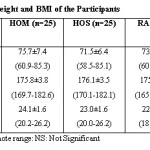 |
Table 5: Mean Weight, Height and BMI of the Participants Click here to View table |
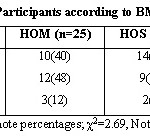 |
Table 6: Distribution of Participants according to BMI Classification20 Click here to View table |
Conclusion
From the findings of the present study, it could be concluded that living arrangements of emerging males influenced their dietary practices, lifestyle patterns and nutritional status. Emerging adults living in hostels seemed to have better involvement in outdoor sports as well as occupational activities related to studies due to easy accessibility to related facilities. They had more regular dietary patterns as they were dependent on meal service at fixed timings which they usually did not miss. They also showed higher intakes of important nutrients and were less likely to be overweight or obese as they had stricter physical activity and dietary regimes and a greater motivation to be fit, being surrounded by their peers most of the time. Though the emerging males living in rented accommodations felt more responsible and independent, the lifestyle practices they sometimes acquired due to lack of adequate parental supervision led to development of adverse health-risk behaviours which could impact their entire lives. Vices such as drinking and smoking were more common among males living on their own. Though home environment may promote some positive lifestyle patterns and protect from risk behaviours like smoking and drinking, this may sometimes become too stifling for the emerging males who are in the transitional period of becoming independent and self-sufficient. Living in hostels seemed to provide the right balance between a totally independent life in rented accommodations and a controlled life at home under parental supervision, by providing autonomy as well as control in the correct dose under some adult supervision in the form of hostel authorities. It seemed to be exactly the kind of environment that the emerging adults needed in this unique developmental phase of their lives to become responsible adults and develop healthy dietary and lifestyle practices.
Acknowledgements
The authors would like to express their grateful thanks to the Director, Institute of Home Economics, University of Delhi for providing the facilities to carry out this research and all the participants who actively participated in the study.
Conflict of Interest
The authors declare that there is no conflict of interest.
Source of Funding
None
References
- Arnett J.J. Emerging adulthood – A theory of development from the late teens through the twenties. Psychol. 2000;55(5):469–480.
CrossRef - Arnett J.J. Conceptions of the transition to adulthood among emerging adults in American ethnic groups. New Dir. Child. Adolesc. Dev. 2003;100:63–76
CrossRef - Nelson L.J., Badger S. and Wu B. The influence of culture in emerging adulthood: Perspectives of Chinese college students. J. Behav. Dev. 2004;28:26–36
CrossRef - Greaney M.L., Less F.D., White A.A., Dayton S.F., Riebe D., Blissmer B., et al. College students’ barriers and enablers for healthful weight management: A qualitative study. Nutr. Educ. Behav. 2009;41(4):281–286.
CrossRef - Ford J., Rugg J. and Burrows, R. Conceptualising the contemporary role of housing in the transition to adult life in England. Urban Stud. 2002;39(13):2455–2467.
CrossRef - Beerman K.A. Variation in nutrient intake of college students: A comparison by students’ residence. Am. Diet. Assoc. 1991;91:343–344.
- Beerman K.A., Jennings G. and Crawford S. The effect of student residence on food choice. Am. Coll. Health. 1990;38:215–220.
CrossRef - Brevard P.B. and Ricketts C.D. Residence of college students affects dietary intake, physical activity, and serum lipid levels. Am. Diet. Assoc. 1996;96(1):35–38.
CrossRef - Wechsler H., Jae E.L., Kuo M., Seibring M., Nelson T.F. and Lee H. Trends in college binge drinking during a period of increased prevention efforts: Findings from 4 Harvard School of Public Health College Alcohol Study surveys: 1993–2001. Am. Coll. Health. 2002;50:203–217.
CrossRef - Harris K.M., Gordon-Larsen P., Chantala K. and Udry J.R. Longitudinal trends in race/ethnic disparities in leading health indicators from adolescence to young adulthood. Pediat. Adol. Med. 2006;160(1):74–81.
CrossRef - Grace T.W. Health problems of college students. Am. Coll. Health. 1997;45:243–250.
CrossRef - Ha E.J. and Caine-Bish N. Effect of nutrition intervention using a general nutrition course for promoting fruit and vegetable consumption among college students. Nutr. Educ. Behav. 2009;41(2): 103–109.
CrossRef - Yusko D.A., Buckman J., White H.R. and Pandina R.J. Alcohol, Tobacco, Illicit Drugs, and Performance Enhancers: A Comparison of Use by College Student Athletes and Nonathletes. Am. Coll. Health. 2008;57:281–289.
CrossRef - Brunt A.R. and Rhee Y.S. Obesity and lifestyle in US college students related to living arrangements. Appetite. 2008;51(3):615–621.
CrossRef - Norman J.E., Bild D., Lewis C.E., Liu K. and West D.S. The impact of weight change on cardiovascular disease risk factors in young black and white adults: the CARDIA study. J. Obes. Relat. Metab. Disord. 2003;27:369–376.
CrossRef - Carnethon M.R., Loria C.M., Hill J.O., Sidney S., Savage P.J. and Liu K. Risk factors for the metabolic syndrome: the CARDIA study, 1985–2001. Diabetes Care. 2004;27:2707–2715.
CrossRef - Mokdad A.H., Marks J.S., Stroup D.F. and Gerberding J.L. Actual causes of death in the United States, 2000. 2004;291:1238–1245.
- Gopalan C., Ramasastri B.V., Balasubramanian S.C., Narasinga Rao B.S., Deosthale Y.G. and Pant K.C. Nutritive Value of Indian Foods. NIN, Indian Council of Medical Research. 1989
- Indian Council of Medical Research. Nutrient requirements and recommended dietary allowances for Indians. A report of the expert group of the I.C.M.R., New Delhi. 2010.
- Misra A., Chowbey P., Makkar B.M., Vikram N.K., Wasir J.S., Chadha D., et al. Consensus statement for diagnosis of obesity, abdominal obesity and the metabolic syndrome for Asian Indians and recommendations for physical activity, medical and surgical management. Assoc. Physicians India. 2009;57:163–170.
- Lupi S., Bagordo F., Stefanati A., Grassi T., Piccinni L., Bergamini M., De Donno A. Assessment of lifestyle and eating habits among undergraduate students in northern Italy. Ann Ist Super Sanita. 2015;51(2):154–161.
- Jones D.H., Harel Y. and Levinson R.M. Living arrangements, knowledge of health risks, and stress as determinants of health-risk behaviour among college students. Am. Coll. Health. 1992;41(2): 43–48.
CrossRef - Benz M.B., DiBello A.M., Balestrieri S.G., Miller M.B., Merrill J.E., Lowery A.D., Mastroleo N.R., Carey K.B. Off-Campus Residence as a Risk Factor for Heavy Drinking Among College Students. Use Misuse. 2017;52(9):1236–1241.
CrossRef - Choi S., Lee Y. Relationship of College Students’ Residence to Frequency of Meal Skipping and Snacking Pattern. Acad. Nutr. Diet. 2012;112(9):A24.
CrossRef - Ansari W.E., Stock C., Mikolajczyk R.T. Relationships between food consumption and living arrangements among university students in four European countries – A cross-sectional study. J. 2012; 11(1):28.
- Laska N., Larson N.I., Neumark-Sztainer D. and Story M. Dietary patterns and home food availability during emerging adulthood: Do they differ by living situation? Public Health Nutr. 2010;13(2):222–228.
CrossRef

This work is licensed under a Creative Commons Attribution 4.0 International License.






